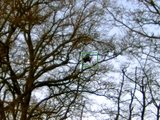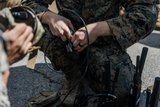Harris introduces Falcon networking system
Harris Corporation has unveiled the Harris Falcon networking system, an integrated and ruggedised end-to-end system for connecting warfighters in the field to the tactical cloud. According to a 22 February 2012 statement, the system broadens and simplifies the delivery of secure video, data and other crucial command and control applications over both wideband tactical and emerging cellular networks.
The system is designed to address the fact that warfighters today face challenges accessing data when their missions take them beyond the range of command centre infrastructure. It combines information technology resources, such as a computer server and Falcon wideband tactical radio, into an integrated, lightweight package that can be deployed to support missions at the tactical edge. By utilising the Falcon networking system, tactical users can now access applications and other critical data files that were previously beyond their reach due to constraints in bandwidth and power.
To help transform the user experience in military communications, Harris designed the Falcon networking system with a 4G tactical cellular module that will enable warfighters to use ruggedised smartphones and other lightweight devices on the battlefield. Harris also introduced a ruggedised tablet device for military applications that is designed to integrate with the Falcon networking system.
The latest Harris integrated networking system includes Falcon III multiband tactical radios, a network communications server, tactical cellular transceiver and intuitive edge devices. Built for upgradeability, the system can expand to incorporate additional devices.
Tactical cellular service in the system adds capacity, speed and 4G LTE standards to the battlefield with all key components — antennas, filters, baseband and controls — contained in a rugged enclosure. The system contains an LTE Core that provides basic voice, data, video and network management through a standards-based solution compatible with commercial user equipment. Future enhancements will include roaming and composed security solutions.
More from Digital Battlespace
-
![Chess Dynamics successfully demonstrates Vision4ce AI-driven tracker]()
Chess Dynamics successfully demonstrates Vision4ce AI-driven tracker
The Vision4ce Deep Embedded Feature Tracking (DEFT) technology software is designed to process video and images by blending traditional computer vision with artificial intelligence (AI) algorithms to present actionable information from complex environments.
-
![Wave Relay devices cleared for security use on commercial systems in industry trend]()
Wave Relay devices cleared for security use on commercial systems in industry trend
Persistent Systems has been cleared by National Security Agency (NSA) to transmit sensitive data on commercial networks. The devices are added to the NSA’s Commercial Solutions for Classified (CSfC) component list which also includes other companies’ products providing the same security.
-
![UK teases cyber spending boost in Strategic Defence Review ahead of “imminent” release]()
UK teases cyber spending boost in Strategic Defence Review ahead of “imminent” release
The release of the UK’s Strategic Defence Review (SDR) has been long promised as mid-year. It is possible it could be as early as 2 June although the UK Ministry of Defence (MoD) continues to play its cards close to its chest.
-
![Intelsat emphasises SATCOM resilience for SOF in contested domains (video)]()
Intelsat emphasises SATCOM resilience for SOF in contested domains (video)
Intelsat outlines how its multi-orbit SATCOM architecture is enhancing connectivity and resilience for special operations forces operating in degraded and contested environments.
-
![US Space Force’s next-generation missile warning system moves forward with $500 million in new contracts]()
US Space Force’s next-generation missile warning system moves forward with $500 million in new contracts
Next-Generation Overhead Persistent Infrared (Next-Gen OPIR) satellites are intended to provide early warning of missile launches from any location worldwide and new ground stations will result in expanded coverage of critical missile warning.
























